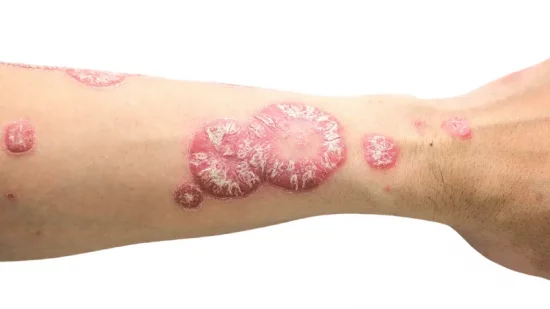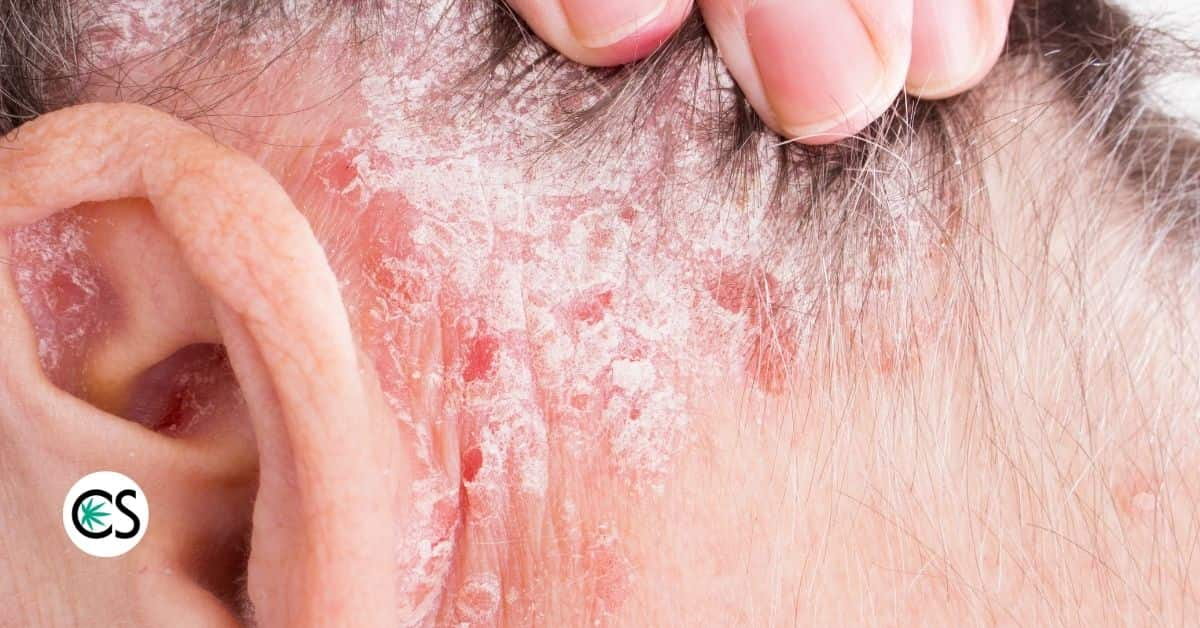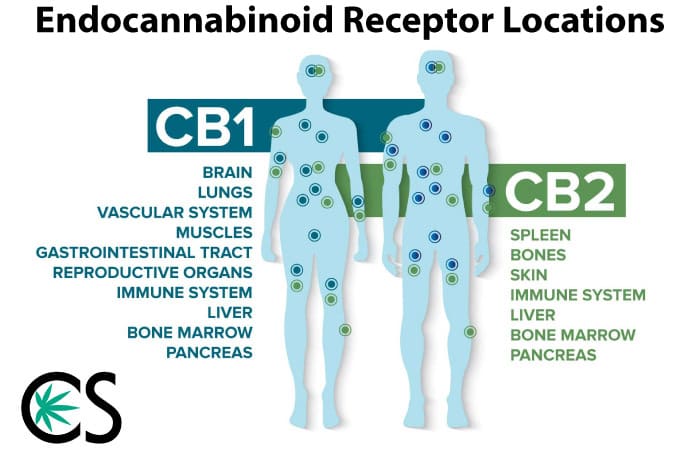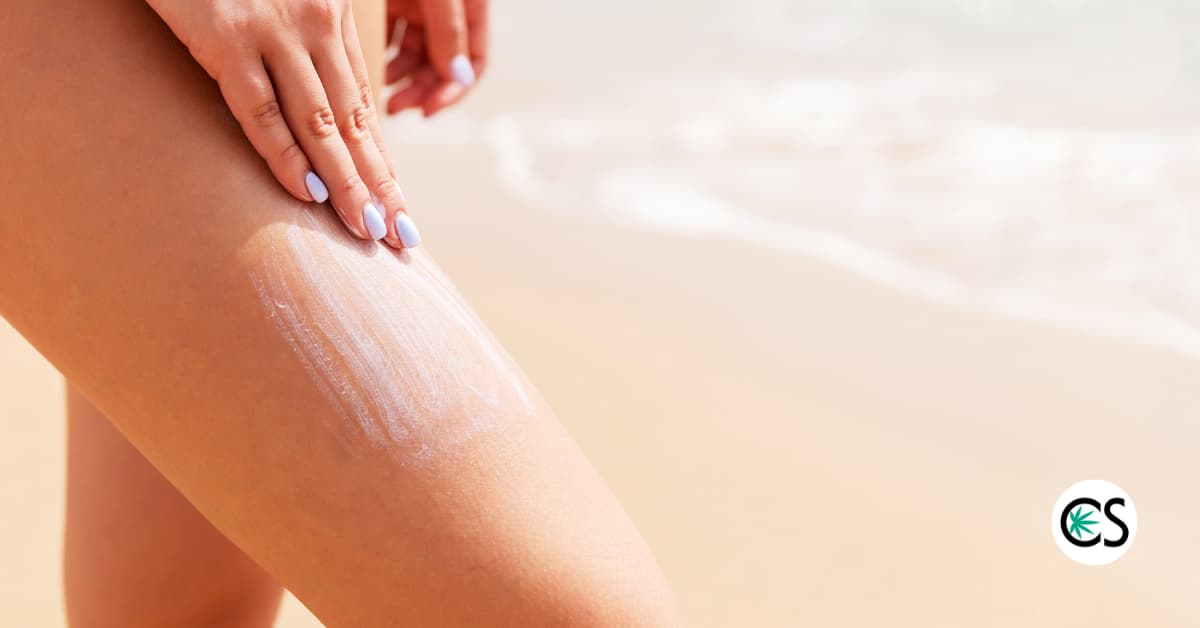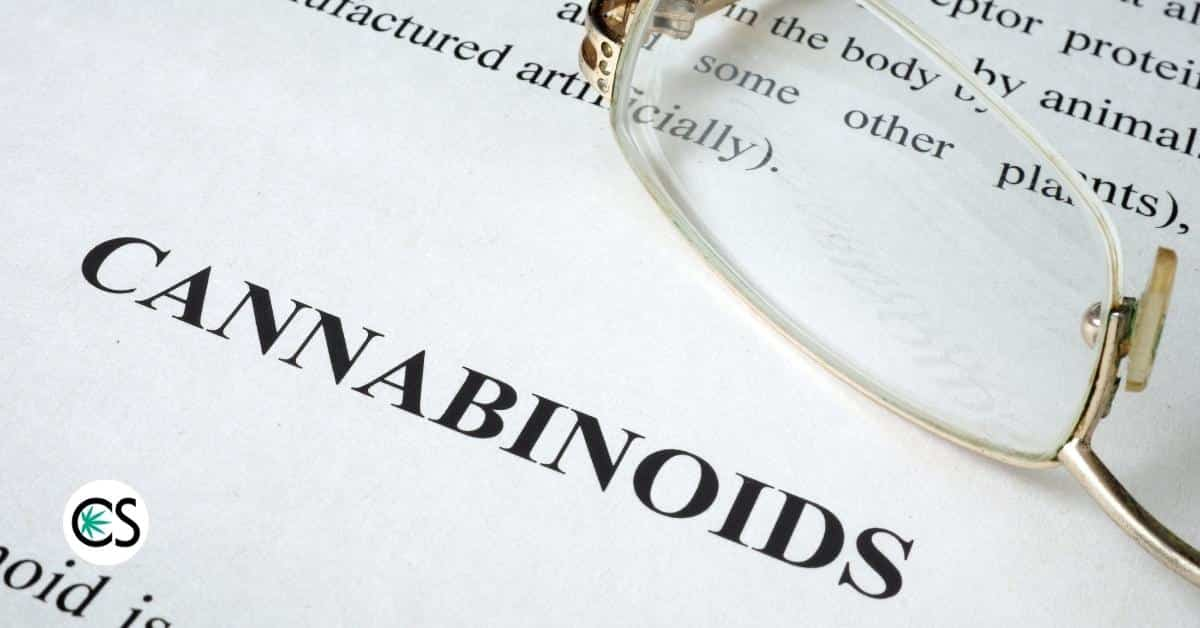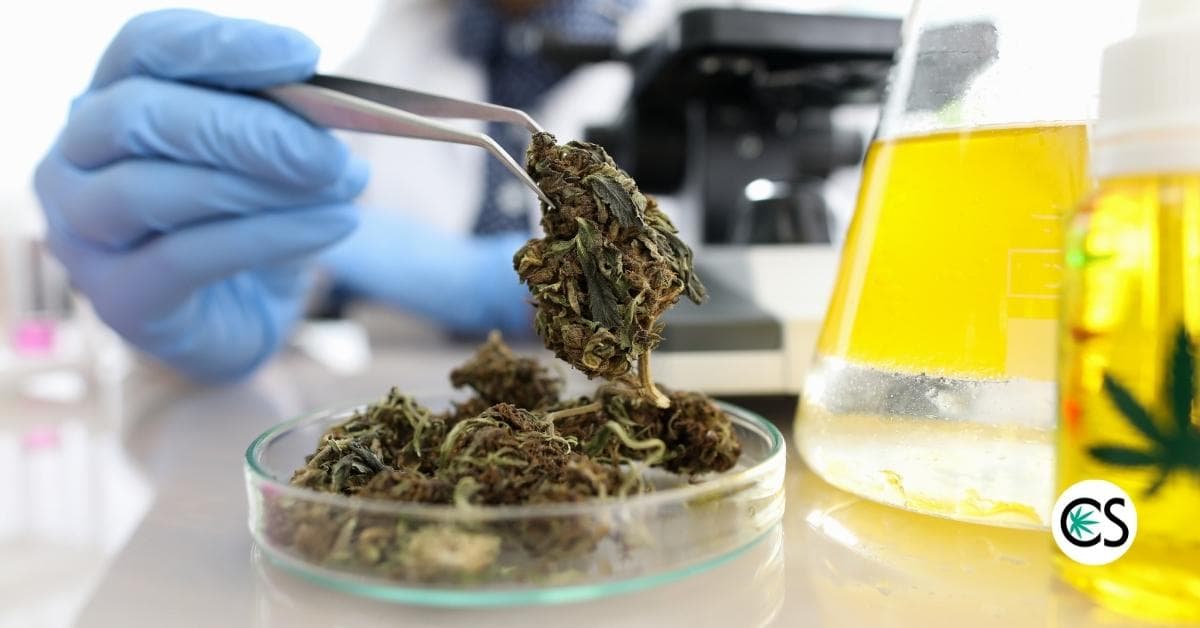Every year, roughly 7 million Americans suffer from some form of psoriasis. Although there are dozens of treatments and medications for psoriasis, many carry the risk of side effects that can be just as bad or even worse than the disease itself. For this reason, scientists and patients alike are always on the lookout for better ways to treat and cope with psoriasis.
In the article that follows, we will take a deep dive into one relatively new and low-risk treatment option: CBD for psoriasis.
What is Psoriasis and What Causes It?
In simplest terms, psoriasis is an autoimmune condition. Plaque psoriasis is the most common form of psoriasis. An autoimmune disease is one that attacks healthy cells as if it’s fighting an infection (allergies are the most well-known autoimmune diseases).
Psoriasis mostly affects keratin-producing skin cells known as keratinocytes. A person with psoriasis’ autoimmune response to a wide range of stimuli triggers the proliferation, or overgrowth, of keratinocytes. Instead of serving their function, dying off, and flaking away over the span of about a month, as they would in a healthy person, keratinocytes in those with psoriasis pile up. This results in the characteristic red or purple plaques topped with silvery scales.
As for what causes psoriasis, scientists are still unsure. They believe that genetics plays a part, as psoriasis seems to run in families. Beyond that, there is no known cause. As mentioned above, though, psoriasis is an autoimmune disease, and therefore a stimulus has to trigger the body’s immune response in order for symptoms to arise—and scientists do know a thing or two about the triggers.
Many different stimuli can provoke psoriasis outbreaks. Some include mild trauma to the skin, such as scratching, piercings, tattoos, sunburns, or chemical irritants. Certain medications are also known to induce or exacerbate episodes: beta-blockers, lithium, antimalarials, and non-steroidal anti-inflammatory agents being the most prevalent.1 Psoriasis is also triggered by cold, dry weather, stress, smoking, and alcohol.
What Are Psoriasis Symptoms?
The immediate physical psoriasis symptoms are fairly straightforward; patients most commonly report itching and burning sensations, as well as cracked dry skin that may lead to bleeding.2 Even more distressing, when it comes to the physical implications of psoriasis, is the increased risk for several other chronic diseases. People with psoriasis are more likely to develop psoriatic arthritis, metabolic syndrome, cardiovascular disorders, non-alcoholic fatty liver disease, Crohn’s disease, and lymphoma.3
In addition to the physical symptoms, people with psoriasis are also known to suffer from severe psychological consequences. In fact, a study that compared several chronic disorders, including cancer and congestive heart failure, found that only depression and chronic lung disease impaired the “psychological quality” of life more than psoriasis.4 To make matters worse, people who suffer from psoriasis also suffer from higher rates of both anxiety and depression.
My patients have reported that CBD helps to reduce both the scaling and flaking as well as the underlying redness.
Dr. Rachna Patel
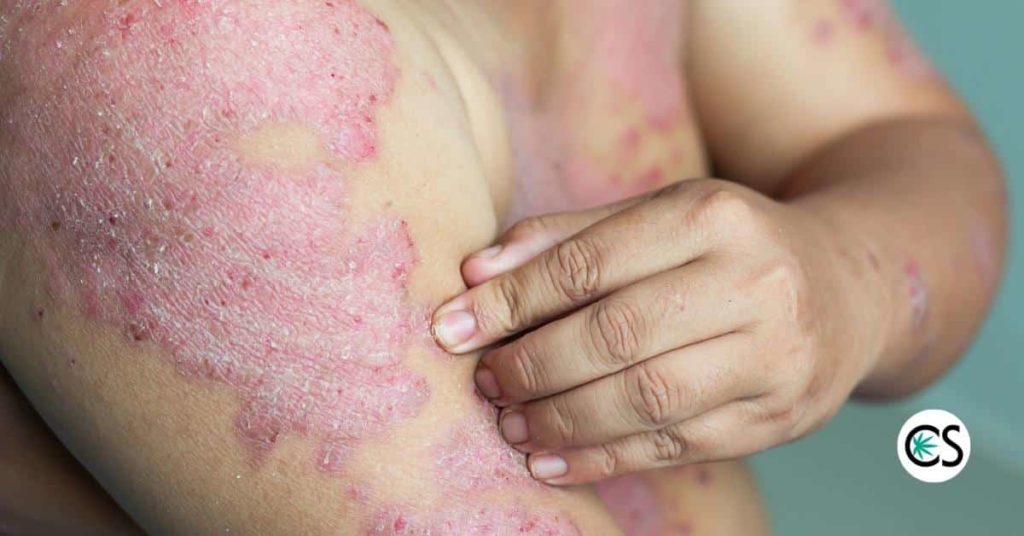
Typical Treatment Methods for Psoriasis, and What Are Their Side Effects?
Traditional treatments for psoriasis varies greatly in accordance with the severity of the disease. Doctors usually treat mild cases with a combination of topical therapies, including corticosteroids, vitamin D analogs, tazarotene (Tazorac), and calcineurin inhibitors. Local adverse effects are common with topical corticosteroids and include skin atrophy, irritation, and impaired wound healing. Systemic effects, such as insomnia, high blood sugar, and facial flushing, occur with an extended course of high doses.5
For moderate-to-severe cases of psoriasis, doctors utilize both phototherapy (light therapy) and systemic therapy (medications that target the immune system as a whole, as opposed to only the regions with a psoriasis flare up).
The most common phototherapy used in psoriasis treatment is narrow-band UVB, which involves exposure to ultraviolet radiation on either the entire body or just the afflicted region. Its side effects consist of burning, skin aging, and skin cancer.6
The second most common phototherapy treatment for psoriasis is a photochemotherapy treatment known as PUVA (psoralen plus UVA), in which patients are given a drug called psoralen that helps the body absorb the ultraviolet radiation. PUVA’s side effects include all of the ones associated with narrow-band UVB treatment, with the inclusion of a few extras: itching, nausea, tanning, and eye damage.7
While the side effects of phototherapy sound scary, the adverse impacts of systemic therapy aren’t much better. The most common systemic drugs prescribed for the treatment of psoriasis are methotrexate, ciclosporin, and acitretin. Their side effects include dangerous drug-drug interactions for people on other medications, cumulative organ toxicities after long-term usage, as well as, once again, a higher risk for skin cancer—not to mention depression, aggressive thoughts, and liver problems.
A Brief Introduction to Cannabinoids
Before we dive into the scientific literature surrounding the treatment of psoriasis with cannabis, it’s important that we understand how cannabinoids function in the body.
So, what are cannabinoids? Put simply, cannabinoids are substances that interact with cannabinoid receptors. And what are cannabinoid receptors? They are protein structures on cell surfaces that allow communication and interaction between substances outside of the cell with substances and processes inside the cell.
Scientists have discovered two major cannabinoid receptors within the human body: CB1 receptors, which are primarily concentrated within the central nervous system (but found elsewhere as well), and CB2 receptors, found mainly in immune and gastrointestinal cells.8 Receptors can be conceived as locks into which only specific keys fit, the cannabinoids themselves being the keys.
The human body produces its own cannabinoids naturally, the two most prevalent being anandamide (AEA) and 2-arachidonoylglycerol (2-AG). These are known as endogenous cannabinoids or endocannabinoids. Endocannabinoids and their receptors compose what is known as the body’s endocannabinoid system (ECS). Another class of naturally-occurring cannabinoids is phytocannabinoids or plant-based cannabinoids. So far, phytocannabinoids have only been discovered in, you guessed it, cannabis. More than 110 phytocannabinoids have been identified within cannabis, but the two most well-known are delta-9 tetrahydrocannabinol (THC) and cannabidiol (CBD).
Can CBD Help with Psoriasis?
For starters, just like corticosteroids, cannabis is notorious for its anti-inflammatory properties, which it achieves through the modulation of cytokine production; in other words, cannabinoids like THC help the body regulate its cytokine production during immune responses (cytokines are a class of substances secreted by the body’s immune system).9 That being said, newer studies indicate that cannabis’s therapeutic value in the treatment of psoriasis extends well beyond anti inflammatory effects.
A study conducted by Jonathan D. Wilkinson and Elizabeth M. Williamson10 researched the effect of cannabinoids specifically on keratinocyte proliferation, which, as you’ll recall, is the primary mechanism of psoriasis. (Note that scientists had already demonstrated by this time that all major components of the ECS are present in human skin)11 The scientists isolated a live culture of keratinocytes and incubated them within a concoction of chemicals conducive to their growth. This process was repeated five times (four for the different phytocannabinoids, one for control). They then treated the keratinocytes with pure THC, CBD, cannabinol (CBN), and cannabigerol (CBG) extracts.
Amazingly, all four phytocannabinoid treatments resulted in the inhibition of keratinocyte proliferation. Using the half-maximal inhibitory concentration (IC50), the scientists were even able to rank the phytocannabinoids by their effectiveness (the IC50 value, in this case, was the amount of a cannabinoid needed to reduce keratinocyte proliferation by 50 percent). CBD produced the lowest IC50 (and therefore the strongest inhibitory effect) at 2 micromoles, followed by CBN at 2.1, CBG at 2.3, and THC at 2.9. In other words, all four major plant-based cannabinoids effectively slowed keratinocyte overgrowth, with the benefits of CBD being the best of them all.
Studies Involving Actual Patients with Psoriasis
Although studying the effects of cannabinoids on keratinocyte proliferation in vitro (in a petri dish or test tube) is certainly worthwhile and in many ways revelatory, it isn’t quite the same as testing cannabinoids on people who actually suffer from psoriasis. Luckily, we found one study that did exactly that.
A team of scientists recruited a group of 20 volunteers with severe skin diseases (five with active psoriasis, five with active atopic dermatitis, and ten with scars from old episodes with either psoriasis or atopic dermatitis). They instructed their volunteers to administer a CBD oil-based skincare ointment to their lesioned skin areas twice daily (once in the morning, once at night) for three months.
In order to evaluate the results, they used four different measurements. The first was skin hydration and transepidermal water loss (TEWL: the amount of water that evaporates from the epidermis into the surrounding atmosphere over a given amount of time), the second was skin elasticity, the third was photographic assessments at 30-day intervals, and the fourth was questionnaires that assess symptoms (including the Psoriasis Area Severity Index (PASI)). Hydration, TEWL, and elasticity were tested on patients’ foreheads, left and right cheeks (malar areas), and left and right sides of their necks. The elasticity of patients’ forearms was also tested as a control since forearm elasticity is relatively fixed.
After three months of treatment, all evaluated parameters improved significantly in all patients. Hydration increased, on average, between 5.5 and 7 percent in the various parts of the body. TEWL improved between 17.6 and 28.1 percent, and elasticity improved between 17.1 and 27.1 percent. PASI scores also improved tremendously.12 Basically, the benefits of CBD cream worked wonders in all 20 patients. Though this is a rather small sample size, a 100 percent success rate across all parameters is nothing to scoff at.
Side Effects to Treating Psoriasis with CBD
One of the only well-documented side effects of medical cannabis consumption is cannabinoid hyperemesis syndrome (CHS), which results in abdominal pain, nausea, and vomiting.13 That being said, one major study found that 96.8 percent of people’s symptoms disappeared entirely after cessation of cannabis ingestion, and 92.3 percent of people were able to relieve their symptoms with hot bathes.14
Now, whether it’s CBD or THC leading to Cannabinoid Hyperemesis Syndrome is yet to be determined. In animal studies, the effect of CBD on toxin-induced vomiting was biphasic, meaning that while low doses reduced or even eliminated vomiting, high doses induced further vomiting.15However, at the same time, THC has also been implicated in Cannabinoid Hyperemesis Syndrome.16
Overall, though Cannabinoid Hyperemesis is generally observed in habitual Cannabis users vs. naive Cannabis users.17
CBD for Psoriasis Q&A with Dr. Rachna Patel
Do certain cannabis products work better than others in treating psoriasis?
When it comes to autoimmune conditions, including psoriasis, in my clinical experience, I’ve found that patients find products containing similar amounts of both CBD and THC most effective, whether it’s a product used internally or externally.
However, products containing similar amounts of both CBD and THC are marijuana-based. And marijuana-based products are accessible only in states or countries that have legalized marijuana for medical or recreational purposes.
Having said that, some of my patients have opted to utilize hemp-based CBD products just because they’re more accessible, and have found them to be effective for their psoriasis.
On a related note, you may be wondering about whether full spectrum or broad spectrum CBD are more effective in treating psoriasis. For those who may not know, full spectrum CBD products contain all the various cannabinoids, including less than 0.3% of THC, while broad spectrum CBD contain all the minor cannabinoids but no more than 0.00% THC. Both work equally effectively with the symptoms of psoriasis.
Going one step further, I often get questions about using ingestible CBD products such as CBD oil tinctures vs. topical treatment such as lotions or balms for the treatment of Psoriasis. I’ve addressed this in detail in the question below: “Should I use a topical application or an edible CBD for psoriasis?”
What results have your patients experienced by using CBD products for their Psoriasis?
My patients have reported that CBD has helped with their psoriasis in several different ways.
One of the most common symptoms of psoriasis is inflammation of the skin, including scalp inflammation, which shows up as scaly skin with redness of the underlying skin conditions.
My patients have reported that CBD helps to reduce both the scaling and flaking as well as the underlying redness.
The other most common symptom of psoriasis is painful joints. The underlying inflammation of the autoimmune conditions leads to stiffness and swelling in the joints throughout the body. As you can imagine this causes patients a whole lot of pain.
I’ve had patients report that CBD helps to reduce the pain associated with their joints.
Overall, pain relief does improve the patient’s quality of life. I’ve had patients tell me that they’re able to perform everyday tasks – from buttoning a shirt to opening bottles to gripping golf clubs – with greater ease.
Should I Use a Topical or an Edible CBD for Psoriasis?
The extent of psoriasis varies from person to person. While some people have scattered localized patches on their elbows, knees, and/or face, others have more extensive psoriasis covering larger areas like the back.
For those with more localized psoriasis, using just CBD cream on the affected area should suffice. Topical CBD creams and oils are locally absorbed.
For those with more extensive psoriasis, using an internal form of CBD, such as an edible or a tincture, is going to be a better option. Internal forms of CBD, such as edibles and tinctures, have systemic effects.
How Do I Use CBD for Psoriasis?
When it comes to figuring out how much to use and how often to use it, it varies from person to person.
As an example, I had 2 patients of similar body shape and size who both struggled with insomnia and were otherwise healthy with no other medical problems. They were on no prescription medications. They both used the exact same CBD product. One patient needed 2.5 mg to sleep better and the other patient needed 50 mg of CBD to sleep better. And there you go – that’s a huge variation in milligrams of CBD needed from person to person!
If your doctor doesn’t recommend a dosage, it’s best to start with a smaller amount and gradually increase it. This could mean starting with as little as 1mg a day. If you need more, increase gradually until you hit your sweet spot and feel that it’s effectively treating your symptoms.
Overall, you want to aim for the minimal effective dose. You don’t want to take too little, wherein the CBD product is not effective. But, you don’t want to take too much, wherein you start to experience the side effects of CBD. Believe it or not, CBD just like any other medication does in fact have side effects, such as dry mouth, diarrhea, reduced appetite, drowsiness, and fatigue. Make sure you alert your physician first that you’re using CBD as CBD does have the potential to raise liver enzymes in very specific cases.
It’s the same when it comes to frequency of dosing, you want to aim for the minimal effective frequency. Overall, there’s a common misconception that CBD products need to be taken on a daily basis. It’s only in rare instances that I have my patients take CBD products on a daily basis. In fact, I tell them to take CBD products at most every other day. You can certainly take CBD products less than every other day. Many of my patients have.
Because CBD is fat-soluble, it gets stored in the fat cells in your body. And over a period of days, the CBD is slowly released into your bloodstream.
How Do I Use Topical CBD Creams for Psoriasis?
First and foremost, when selecting a topical CBD cream for your psoriasis, it is of utmost importance to ensure that it is not made with a base of alcohol. Alcohol dries out the skin and has the potential to further exacerbate the symptoms of your psoriasis, not to mention that applying alcohol to inflamed skin conditions leads to burning and stinging.
Additionally, it’s important to not apply the topical CBD to broken skin as it could potentially lead to infection. On a side note, make sure the CBD topical you’re about to purchase has been tested for microbial contaminants, like fungus and bacteria. Surprisingly, not all leading CBD products on the market today have been tested.
Using the CBD topical is fairly straight-forward, apply a pea-sized amount to the affected area. As little as a once a day application should suffice.
Conclusion
While more research is needed to determine the effectiveness of CBD products for psoriasis, the initial results show promise. There are thousands of CBD products now on the market. If you’re interested in trying CBD creams, we’ve tested many of those available and provided our recommendations here: 10 Best Topical CBD Creams.
Disclaimer
CBD and other cannabinoids are classified as food/dietary supplements, NOT as FDA-approved medications. We therefore cannot make any medical claims or give any medical advice concerning the healing powers of cannabis; we can only elucidate the available literature on the subject. We can (and do), however, encourage you to research and try cannabis-based products as you see fit.
References
1Basavaraj KH, Ashok NM, Rashmi R, Praveen TK. The role of drugs in the induction and/or exacerbation of psoriasis. Int J Dermatol. 2010;49(12):1351-1361. doi:10.1111/j.1365-4632.2010.04570.x
2Dubertret L, Mrowietz U, Ranki A, et al. European patient perspectives on the impact of psoriasis: the EUROPSO patient membership survey. Br J Dermatol. 2006;155(4):729-736. doi:10.1111/j.1365-2133.2006.07405.x
3Boehncke, W.H., Schön M.P. (2015). Psoriasis. The Lancet, 386(9997), 983-994.
4Rapp SR, Feldman SR, Exum ML, Fleischer AB Jr, Reboussin DM. Psoriasis causes as much disability as other major medical diseases. J Am Acad Dermatol. 1999;41(3 Pt 1):401-407. doi:10.1016/s0190-9622(99)70112-x
5Mayo Clinic (2019, Oct. 9). Prednisone and other corticosteroids
6Oakley AM, Wyllie K. A review of ultraviolet treatment for psoriasis at Waikato Hospital. Australas J Dermatol. 1996;37(3):132-136. doi:10.1111/j.1440-0960.1996.tb01030.x
7Briffa DV, Warin AP. Photochemotherapy in psoriasis: a review. J R Soc Med. 1979;72(6):440-446.
8Zou S, Kumar U. Cannabinoid Receptors and the Endocannabinoid System: Signaling and Function in the Central Nervous System. Int J Mol Sci. 2018;19(3):833. Published 2018 Mar 13. doi:10.3390/ijms19030833
9Klein TW. Cannabinoid-based drugs as anti-inflammatory therapeutics. Nat Rev Immunol. 2005;5(5):400-411. doi:10.1038/nri1602
10Wilkinson JD, Williamson EM. Cannabinoids inhibit human keratinocyte proliferation through a non-CB1/CB2 mechanism and have a potential therapeutic value in the treatment of psoriasis. J Dermatol Sci. 2007;45(2):87-92. doi:10.1016/j.jdermsci.2006.10.009
11Ständer S, Reinhardt HW, Luger TA. Topische Cannabinoidagonisten. Eine effektive, neue Möglichkeit zur Behandlung von chronischem Pruritus [Topical cannabinoid agonists. An effective new possibility for treating chronic pruritus]. Hautarzt. 2006;57(9):801-807.
12Palmieri B, Laurino C, Vadalà M. A therapeutic effect of cbd-enriched ointment in inflammatory skin diseases and cutaneous scars. Clin Ter. 2019;170(2):e93-e99. doi:10.7417/CT.2019.2116.
13Galli JA, Sawaya RA, Friedenberg FK. Cannabinoid hyperemesis syndrome. Curr Drug Abuse Rev. 2011;4(4):241-249. doi:10.2174/1874473711104040241
14Sorensen CJ, DeSanto K, Borgelt L, Phillips KT, Monte AA. Cannabinoid Hyperemesis Syndrome: Diagnosis, Pathophysiology, and Treatment-a Systematic Review. J Med Toxicol. 2017;13(1):71-87. doi:10.1007/s13181-016-0595-z
15Parker LA, Rock EM, Limebeer CL. Regulation of nausea and vomiting by cannabinoids. Br J Pharmacol. 2011;163(7):1411-1422. doi:10.1111/j.1476-5381.2010.01176.x
16Galli JA, Sawaya RA, Friedenberg FK. Cannabinoid hyperemesis syndrome. Curr Drug Abuse Rev. 2011;4(4):241-249. doi:10.2174/1874473711104040241
17Iacopetti CL, Packer CD. Cannabinoid hyperemesis syndrome: a case report and review of pathophysiology. Clin Med Res. 2014;12(1-2):65-67. doi:10.3121/cmr.2013.1179
